Bulletin – June 2005 The Australian Foreign Exchange and Derivatives Markets
Activity in Australia's foreign exchange and derivatives markets has increased at a rapid pace in recent years. According to the most recent Bank for International Settlements (BIS) Triennial Survey of Foreign Exchange and Derivatives Market Activity,[1] turnover in the Australian foreign exchange market increased by nearly 60 per cent since the previous survey in 2001 (Graph 1). Growth in turnover has occurred across all instruments, currencies and counterparties. In terms of global turnover, the AUD/USD is the fourth most traded currency pair, and the Australian dollar the sixth most actively traded currency, while the Australian foreign exchange market is the seventh largest in the world.
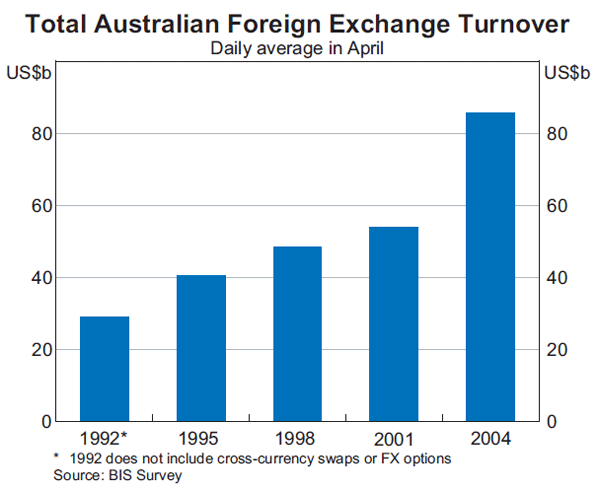
The Australian Foreign Exchange Market[2]
Foreign exchange turnover in all currencies in the Australian market averaged US$81 billion per day in April 2004, an increase of 56 per cent on the average daily turnover recorded in the previous BIS survey conducted in April 2001. Growth in the Australian market outpaced growth in global turnover: over the same period, global foreign exchange turnover in traditional instruments increased by around 50 per cent.[3] Consequently, Australia's market share of global turnover increased marginally to 3.4 per cent in 2004. The Australian foreign exchange market is the seventh largest in the world (Table 1).
| 1992 | 1995 | 1998 | 2001 | 2004 | |
|---|---|---|---|---|---|
| United Kingdom | 27.0 | 29.5 | 32.4 | 31.2 | 31.3 |
| United States | 15.5 | 15.5 | 17.8 | 15.7 | 19.2 |
| Japan | 11.2 | 10.2 | 6.9 | 9.1 | 8.3 |
| Singapore | 6.9 | 6.7 | 7.1 | 6.3 | 5.2 |
| Germany | 5.1 | 4.8 | 4.8 | 5.4 | 4.9 |
| Hong Kong | 5.6 | 5.7 | 4.0 | 4.1 | 4.2 |
| Australia | 2.7 | 2.5 | 2.4 | 3.2 | 3.4 |
| France | 3.1 | 3.7 | 3.7 | 3.0 | 2.6 |
| Canada | 2.0 | 1.9 | 1.9 | 2.6 | 2.2 |
| Netherlands | 1.9 | 1.7 | 2.1 | 1.9 | 2.0 |
| Denmark | 2.5 | 2.0 | 1.4 | 1.4 | 1.7 |
| Sweden | 2.0 | 1.3 | 0.8 | 1.5 | 1.3 |
|
(a) Turnover of spot, outright forwards and foreign exchange swaps (adjusted for local inter-dealer double counting) Source: BIS survey |
|||||
The AUD/USD remained by far the most traded currency pair in the Australian market, although its share in total transactions declined from 53 per cent in 2001 to 49 per cent in 2004 (Table 2). Coincident with some large US and European investment banks relocating their Asian-Pacific trading desks to Sydney, the share of trade in EUR/USD in the Australian market increased significantly over the same period to 16 per cent, and is now the second most traded currency pair in Australia.
| 1989 | 1992 | 1995 | 1998 | 2001 | 2004 | |
|---|---|---|---|---|---|---|
| AUD/USD | 55.2 | 40.3 | 42.0 | 53.9 | 53.3 | 48.8 |
| EUR/USD | – | – | – | – | 10.1 | 15.8 |
| USD/DEM | 14.7 | 20.7 | 21.7 | 12.3 | – | – |
| USD/JPY | 9.3 | 17.8 | 13.3 | 14.3 | 13.8 | 11.5 |
| GBP/USD | 8.0 | 8.6 | 7.0 | 4.6 | 5.6 | 5.6 |
| NZD/USD | 2.2 | 1.3 | 3.2 | 5.8 | 8.1 | 5.9 |
| USD/CHF | 5.1 | 2.5 | 2.6 | 0.8 | 1.0 | 1.2 |
| Other | 5.5 | 8.8 | 10.2 | 8.3 | 8.1 | 11.2 |
|
(a) Turnover calculated on a gross basis (not adjusted for local inter-dealer double counting) Source: BIS survey |
||||||
The expansion of the Australian foreign exchange market reflected growth in all traditional instruments (Graph 2). Transactions in the spot market grew by 94 per cent between 2001 and 2004. Activity in the outright forwards market increased by 45 per cent and in the foreign exchange swaps market by 43 per cent. However, this has not substantially altered the share of foreign exchange turnover accounted for by each traditional instrument. Foreign exchange swaps transactions continue to represent the highest share, comprising 62 per cent of the Australian market, followed by spot (32 per cent) and outright forwards transactions (6 per cent). Compared with the rest of the world, foreign exchange swaps in Australia occupy a larger share of the total market, while spot and outright forwards transactions are relatively smaller. Globally, foreign exchange swaps account for 55 per cent of turnover, while spot and outright forwards transactions comprise 34 per cent and 11 per cent respectively.
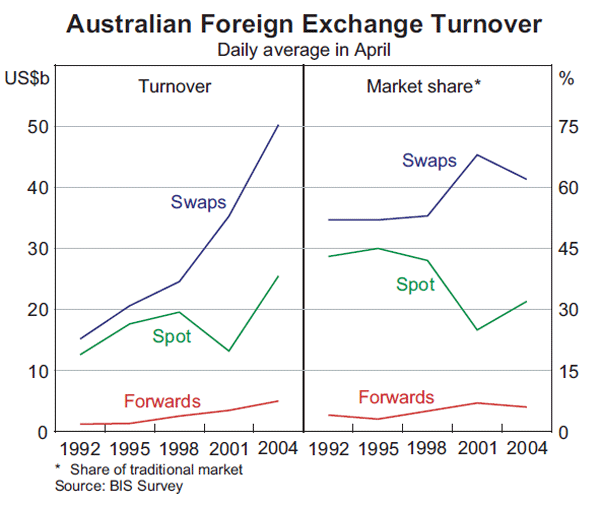
The growth in the Australian market comes at a time when the number of reporting foreign exchange dealers is decreasing. Since the late 1990s, consolidation in the Australian financial services industry and the corporate sector has seen market concentration increase in segments of the foreign exchange market. The increase in concentration is most evident in the spot market; at the time of the recent BIS survey, the top 10 dealers accounted for 91 per cent of total turnover, whereas in 2001 it was 81 per cent and in April 1994, 67 per cent.
Factors Contributing to the Increase in Turnover
The expansion of the Australian foreign exchange market is consistent with the global trends reported by the BIS.[4] Some of the growth in foreign exchange markets reflected a rebound from the subdued level of activity recorded in 2001. However, a primary driver has been the global search for yield which has boosted the treatment of foreign exchange as an asset class for investors.[5] One manifestation of this has been the carry trade, where investors borrowed in currencies with relatively low yields and invested in currencies with relatively high interest rates such as the Australian dollar.
Consistent with this, there is evidence that off-shore investors provided a major impetus to the Australian market's expansion between 2001 and 2004. Much of the pick-up in Australian market turnover was driven by transactions executed with overseas banks (Graph 3).[6] Market commentary indicated an increased presence of off-shore institutional investors such as hedge funds, investment banks and commodity trading accounts (CTAs). From late 2002, these types of investors tended to buy Australian dollars, amongst other currencies, to exploit the downward momentum of the US dollar, using technical rules to signal entry and exit points. In step with increased speculative activity on the Australian dollar, net long futures contracts in the Australian dollar rose to historically high levels in 2003 and early 2004. Another manifestation of the strong off-shore demand was the increased issuance of Australian dollar Eurobonds and Uridashi (Australian dollar debt instruments sold to off-shore retail investors) (Graph 4).
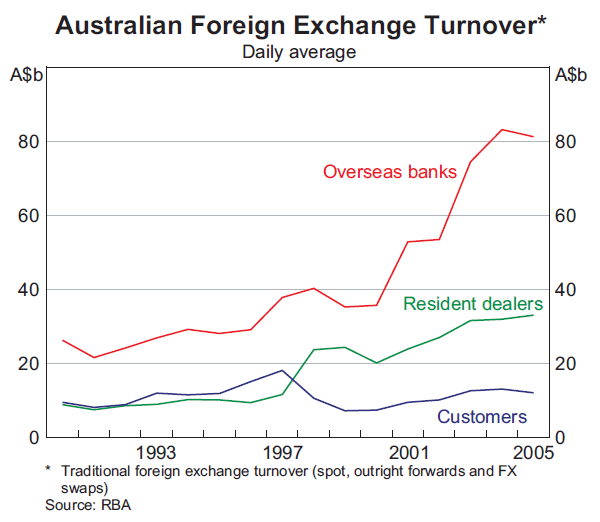
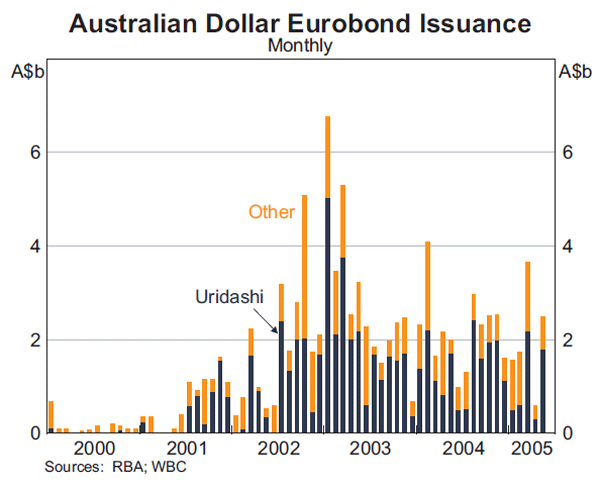
Investment strategies exploiting momentum and relatively high-yielding currencies were supported by a greater tolerance towards risk during 2004. Indicators of investors' risk preference suggest that investors were probably risk-seeking around the time of the 2004 survey. In contrast, around the time of the 2001 BIS survey, investors appear to have been relatively risk averse. Furthermore, the increased volume of funds flowing into hedge funds is likely to have boosted turnover, particularly compared with 2001 when investors were wary of such investment vehicles following the collapse of Long Term Capital Management (LTCM).
Valuation effects from the depreciation of the US dollar over the period also boosted the reported expansion in foreign exchange activity in the Australian market, as the BIS survey is reported in US dollars, while local data are collected in Australian dollar terms. In April 2001 the relevant conversion rate for the Australian market was approximately US50 cents per Australian dollar, compared with US75 cents in April 2004 (an appreciation of around 50 per cent over the period). Nevertheless, even accounting for valuation effects, the Australian market has seen a substantial pick-up in turnover since 2001. Based on data from the RBA monthly turnover survey, using a constant exchange rate, foreign exchange turnover in the Australian market increased by around 25 per cent between April 2001 and April 2004 (Graph 5).[7]
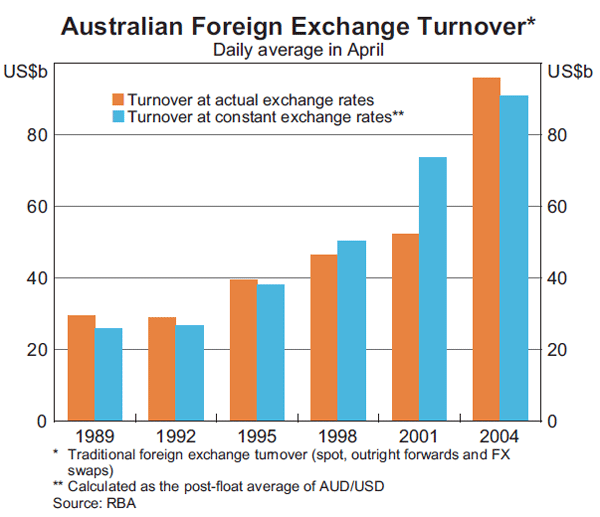
Working in the other direction, there was a refinement of the definition of turnover in the 2004 BIS survey to exclude certain related-party transactions. Cross-border trades conducted as back-to-back deals or purely for internal bookkeeping or internal risk management purposes were excluded, as were trades between the local desks or offices of a respondent (i.e. internal or in-house deals). For the Australian market, this change in definition is estimated to have lowered reported turnover by around 20 per cent in 2004.
The Australian Derivatives Market
Total derivatives turnover in Australia also increased, averaging US$18 billion per day in April 2004, a rise of 47 per cent from the previous BIS survey. As was the case for turnover in traditional foreign exchange instruments, the reported expansion in derivatives activity in the Australian market in part reflected valuation effects from the appreciating Australian dollar, and occurred despite the refinement to the definition of turnover to exclude certain related-party transactions.
The interest rate derivatives market in Australia expanded by 30 per cent, compared with a 97 per cent increase globally. Global turnover in interest rate derivatives was boosted by changes in hedging and trading practices in the US market. These changes were largely a result of the significant volatility experienced in the US Treasury market through mid 2003, because of duration hedging in the mortgage-backed securities market.
Since the last BIS survey, growth in foreign exchange derivatives (options and cross-currency swaps) has outpaced growth in interest rate derivatives both locally and globally. Growth in foreign exchange derivatives markets was spurred by investor demand for more sophisticated risk-management techniques and hedging of the expanding investment in traditional foreign exchange. In line with global trends, turnover in the Australian foreign exchange derivatives market more than doubled to US$5 billion per day.
The Australian foreign exchange derivatives market continued to become more integrated with global financial markets. Offshore counterparties have become increasingly important in Australian derivatives activity; the market share of cross-border transactions increased from 68 per cent in 2001 to 80 per cent in 2004. This theme is also apparent internationally, with cross-border transactions growing at a faster rate than local transactions. Consistent with Australia becoming more connected to the global financial community, the variety of instruments and products available in OTC foreign exchange derivatives has also increased.
Similar to the trends seen in traditional foreign exchange instruments, in the Australian foreign exchange derivatives market investors moved away from US dollar contracts and towards euro contracts. In the past, the US dollar was typically on one side of about 90 per cent of derivatives transactions, with around two-thirds of all transactions written in AUD/USD. In 2004, the market share of US dollar contracts fell to 84 per cent, and the market share of contracts written in AUD/USD to 50 per cent.
Global Trade in the Australian Dollar
The US dollar remained the world's most traded currency in April 2004, albeit by a smaller margin than in the last survey. Consistent with the search for yield described above, currencies with relatively high interest rates, such as the UK pound, Australian dollar and New Zealand dollar, recorded a rise in market share of global turnover. Trade involving the Australian dollar averaged US$103 billion per day in April 2004 – double that from the previous BIS survey.
The Australian dollar was on one side of 5.5 per cent of all global transactions in traditional foreign exchange instruments, making it the sixth most traded currency. The AUD/USD currency pair is the fourth most traded currency pair. Around 40 per cent of global trade in the AUD/USD pair occurred in the Australian market in 2004. This is down considerably from over 50 per cent in 2001, reflecting the increased importance of off-shore investors in foreign exchange markets.
Footnotes
The most recent BIS survey was conducted in April 2004, with the final global results released in March 2005 <www.bis.org/publ/rpfx05.htm>. Results for Australia can be accessed from the RBA website via <http://www.rba.gov.au/media-releases/2004/>. [1]
This section discusses turnover in ‘traditional’ foreign exchange instruments, namely spot, outright forwards and foreign exchange swaps transactions. See below for a discussion of the Australian derivatives market. [2]
Adjusted for cross-border double-counting of transactions. [3]
See G Galati and M Melvin (2004), ‘Why has FX trading surged? Explaining the 2004 triennial survey’, BIS Quarterly Review, December, pp 67–74 (available at <http://www.bis.org/publ/qtrpdf/r_qt0412f.pdf>). [4]
See Box B, Statement on Monetary Policy, February 2005, pp 24–26. [5]
The data in Graph 3 are sourced from the monthly RBA foreign exchange turnover survey. RBA turnover data closely resemble BIS turnover data, but the BIS survey data exclude certain related-party transactions. [6]
These data abstract from the change in the definition of turnover that occurred between the 2001 and 2004 BIS surveys (see below). [7]